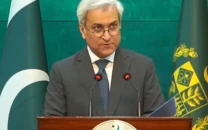Conflict resolution — I
Disputes may be settled through negotiations, but only after the belligerents have exhausted all other options.

Conflict resolution — I
India and Pakistan tried that for 50 years. During this period, they developed internal strength and sought external support, acquired unconventional capabilities and used sub-conventional means and fought wars. Finally in 1997, in the belief that they were now well-positioned, the two countries evolved a framework for peace.
The first challenge was to create the right conditions for a dialogue on Kashmir, the bone of contention between them right from their inception. It had now become so complex that a meaningful discourse seemed nearly impossible. In Pakistan, securing the right of self-determination for the Kashmiris is a national passion. It could not, therefore, embark upon a dialogue that was not seen to be addressing Kashmir. India, on the other hand, having declared the disputed state as its integral part, could not be seen negotiating its status. The foreign secretaries meeting of June 1997 found an ingenuous method to circumvent the dilemma.
The recipe, now known as the “composite dialogue”, was to form a number of working groups to discuss bilateral issues more or less concurrently. Peace, security and Kashmir were to be dealt with by foreign secretaries; others like trade, terrorism, and some territorial disputes by ministries or departments concerned. Pakistan could now claim that its “core issue” would be handled at an appropriately high level, and the Indians were free to explain that the forum was primarily to redress matters like cross-border infiltration. A clause in the agreement, however, could cease the process in its tracks.
A good number of people in Pakistan have always believed that if the two countries settled peripheral disputes before addressing Kashmir, India would have no incentive in its resolution. To assuage that concern, a clause in the joint communiqué (4.2) stated that the dialogue would be conducted as an “integrated” whole — implying that progress on all issues would have to be in tandem. That sounded fine — except for the problem that if there was little or no movement on one track, one would have to slow down on all the others. The favourable environment needed to deal with the more complex problems was thus contingent upon progress on all. This was exactly the catch-22 situation that the authors of the formula had set out to avoid.
The “integrated” part was, therefore, quietly dropped (though not from the official text). The process was now more like moving with our disputes on parallel tracks and settling them according to their degree of difficulty. No longer “composite”, the dialogue retained its politically correct adjective. What we now had was a “multiple-track, multiple-speed” formula.
Evolution of this concept was purely a civilian sector enterprise. However, since it is the military that prides itself in the study and development of strategic wisdom, it may be gratifying to note that a military strategist too would have supported the model. When operating along multiple axes, forces that meet less resistance continue their momentum, thus creating a synergetic effect. In due course, some critical fronts can be reinforced to achieve a breakthrough and capture the main objective — in this case, durable peace in the subcontinent.
Good concepts and sound strategies are indeed not enough. Execution and oversight is the real thing. How the composite dialogue fared on that account will be discussed in subsequent serials.
Published in The Express Tribune, November 5th, 2010.



















COMMENTS
Comments are moderated and generally will be posted if they are on-topic and not abusive.
For more information, please see our Comments FAQ